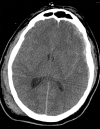Severe Traumatic Brain Injury: A Case Report
- PMID: 27005826
- PMCID: PMC4807741
- DOI: 10.12659/ajcr.897116
Severe Traumatic Brain Injury: A Case Report
Abstract
Background: Traumatic brain injury remains a challenging and complicated disease process to care for, despite the advance of technology used to monitor and guide treatment. Currently, the mainstay of treatment is aimed at limiting secondary brain injury, with the help of multiple specialties in a critical care setting. Prognosis after TBI is often even more challenging than the treatment itself, although there are various exam and imaging findings that are associated with poor outcome. These findings are important because they can be used to guide families and loved ones when making decisions about goals of care.
Case report: In this case report, we demonstrate the unanticipated recovery of a 28-year-old male patient who presented with a severe traumatic brain injury after being in a motorcycle accident without wearing a helmet. He presented with several exam and imaging findings that are statistically associated with increased mortality and morbidity.
Conclusions: The care of severe traumatic brain injuries is challenging and dynamic. This case highlights the unexpected recovery of a patient and serves as a reminder that there is variability among patients.
Figures










References
-
- Bruns J, Jr, Hauser WA. The epidemiology of traumatic brain injury: A review. Epilepsia. 2003;44:2–10. - PubMed
-
- Thurman DJ, Alverson C, Dunn KA, et al. Traumatic brain injury in the United States: A public health perspective. J Head Trauma Rehabil. 1999;14:602–15. - PubMed
-
- Shouten JW, Maas A. Epidemiology of trauma brain injury. Youmans Neurological Surgery. 2011;6:323.
-
- Chesnut RM, Ghajar J, Maas AIR, et al. Early indicators of prognosis in severe traumatic brain injury. J Neurotrauma. 2000;17:614–19.
Publication types
MeSH terms
LinkOut - more resources
Full Text Sources

